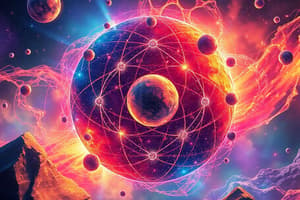Podcast
Questions and Answers
What was Democritus' contribution to the concept of atoms?
What was Democritus' contribution to the concept of atoms?
- He provided experimental evidence to support his theories.
- He postulated that atoms are indivisible particles. (correct)
- He proposed that all matter is made of four basic elements.
- He introduced the idea that matter is composed of divisible elements.
According to Aristotle's idea, what were the basic components of matter?
According to Aristotle's idea, what were the basic components of matter?
- Molecules formed by chemical combinations.
- Atoms made of protons, neutrons, and electrons.
- Four elements: earth, wind, fire, and water. (correct)
- Indivisible particles called atoms.
Which of the following is NOT one of Dalton's major points in his atomic theory?
Which of the following is NOT one of Dalton's major points in his atomic theory?
- Atoms combine in simple numerical ratios to form compounds.
- Atoms can be subdivided into smaller particles. (correct)
- Atoms of the same element are identical in mass.
- Different elements consist of atoms with different masses.
Who is credited with the discovery of the electron?
Who is credited with the discovery of the electron?
What is a significant limitation of Democritus' atomic theory?
What is a significant limitation of Democritus' atomic theory?
What is the observed behavior of cathode rays in an electric field?
What is the observed behavior of cathode rays in an electric field?
Which of the following correctly describes the nature of cathode rays?
Which of the following correctly describes the nature of cathode rays?
What is the charge-to-mass ratio (e/m) of the cathode ray particle measured by J.J. Thomson?
What is the charge-to-mass ratio (e/m) of the cathode ray particle measured by J.J. Thomson?
What was the basic charge found by Millikan for the electron?
What was the basic charge found by Millikan for the electron?
In the Millikan Oil Drop Experiment, what formula is used to relate force, charge, and electric field?
In the Millikan Oil Drop Experiment, what formula is used to relate force, charge, and electric field?
Study Notes
History of Atomic Theory
- Democritus believed matter was made of tiny indivisible particles called atoms.
- Democritus did not have any experimental evidence for his theory.
- Aristotle disagreed with Democritus, believing that matter was made of four elements: fire, dust, water, and air.
- According to Aristotle, any matter can change into another by changing the proportions of these four elements.
Dalton's Atomic Theory
- Dalton proposed four key points to his theory:
- Elements are composed of tiny indivisible particles called atoms.
- Atoms are solid and very small.
- Atoms of the same element have similar masses, but they differ from atoms of other elements.
- Compounds are formed by the combination of atoms of different elements in simple whole-number ratios.
Discovery of the Electron
- J.J. Thomson discovered the electron in 1897 while studying the properties of cathode rays.
J.J. Thomson's Cathode Ray Experiment
- Cathode rays are invisible rays emitted from the negative pole (cathode).
- These rays cause a green fluorescent glow when they hit the wall of the tube.
- Cathode rays behave like negatively charged particles in the presence of an electric field.
Properties of Cathode Rays
- Cathode rays travel in straight lines.
- The material of the cathode does not affect the cathode rays.
- Cathode rays consist of negatively charged particles.
Charge/Mass Ratio of the Electron
- J.J. Thomson measured the charge-by-mass ratio (e/m) of cathode ray particles using the deflection in electric and magnetic fields.
- The value of e/m is -1.76 x 10⁸ coulombs per gram (C/g).
Millikan's Oil Drop Experiment
- Robert Millikan determined the charge of the electron using the oil drop experiment.
- The experiment involved suspending tiny oil droplets between electrically charged plates.
- By studying the motion of the droplets under the influence of gravity and electric fields Millikan determined the fundamental unit of charge, which is the charge of an electron.
Charge of the Electron
- Millikan found that all charges measured were multiples of -1.6 x 10⁻¹⁹ Coulombs.
- The charge of the electron is -1.6 x 10⁻¹⁹ Coulombs.
Mass of the Electron
- Using the charge-by-mass ratio (e/m) and the charge of the electron, the mass of the electron can be calculated.
- The mass of the electron is 9.11 x 10⁻³¹ kg.
Rutherford's Scattering Experiment
- Rutherford's experiment bombarded a thin gold foil with alpha particles.
- Most of the alpha particles passed straight through the gold foil , suggesting that the atom is mostly empty space.
- Some alpha particles were deflected at small angles, indicating the presence of a small, positively charged center called the nucleus.
- A few alpha particles were deflected at large angles, implying that the nucleus is small, dense, and positively charged.
Conclusions from Rutherford's Scattering Experiment
- The atom has a dense, positively charged center called the nucleus.
- The nucleus occupies a very small fraction of the total volume of the atom.
- The atom is not a solid sphere.
- Electrons revolve around the nucleus in closed circular paths at high speeds.
- The number of negatively charged electrons outside the nucleus is equal to the number of positively charged protons in the nucleus.
- The overall electrical neutrality of an atom is explained by the balance between protons and electrons.
Rutherford's Planetary Model of the Atom
- Rutherford's model proposes that the atom resembles the solar system, with a central nucleus (like the sun) and electrons orbiting it (like planets).
Drawbacks of Rutherford's Model
- Rutherford's model could not explain the stability of the atom. According to classical physics, electrons orbiting the nucleus would lose energy and spiral into the nucleus, making the atom unstable.
- Rutherford's model could not explain the radiation emitted by some atoms.
Discovery of the Neutron
- Chadwick discovered the neutron in 1932.
- Neutrons have no electric charge.
- Neutrons are located in the nucleus of an atom, along with protons.
Chadwick's Experiment
- When alpha particles bombarded Beryllium nuclei, radiations were observed.
- These radiations were found to be neutral, meaning they weren't deflected by electric fields.
- Chadwick's observations led to the discovery of the neutron.
Atomic Number and Mass Number
- Atomic Number (Z): The number of protons in an atom.
- Mass Number (A): The total number of protons and neutrons in an atom.
Isotopes
- Isotopes are atoms of the same element that have the same number of protons and electrons but different numbers of neutrons.
- They have the same atomic number but different mass numbers.
Atomic Mass (Weight)
- The atomic mass (weight) of an element is the average mass of an atom of that element, expressed in atomic mass units (amu).
Atomic Mass Unit (amu)
- One atomic mass unit (amu) is equal to 1/12 the mass of a carbon-12 atom (¹²C).
- 1 amu = 1.66 x 10⁻²⁴ g.
Average Atomic Mass (Weight)
- The average atomic mass (weight) of an element is calculated based on the abundance of its isotopes in nature.
- It is determined by weighting the atomic mass of each isotope by its relative abundance.
- Average Atomic Mass (Weight) = (Atomic mass of isotope 1 x its abundance) + (Atomic mass of isotope 2 x its abundance) + ... etc.
Studying That Suits You
Use AI to generate personalized quizzes and flashcards to suit your learning preferences.
Related Documents
Description
Explore the evolution of atomic theory from Democritus to J.J. Thomson's discovery of the electron. This quiz delves into the key concepts proposed by Dalton and the contrasting views of Aristotle. Test your knowledge on these foundational ideas in chemistry.




